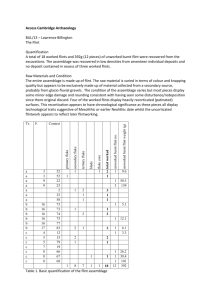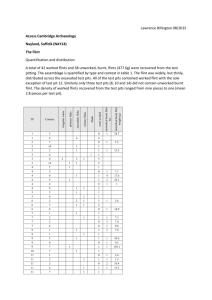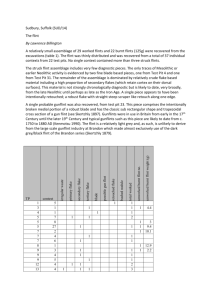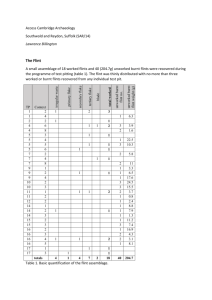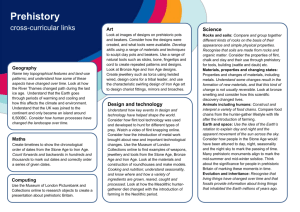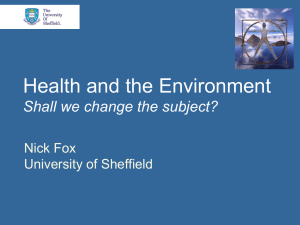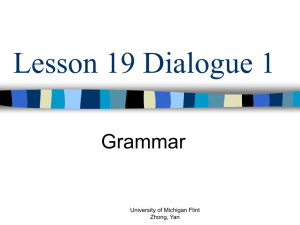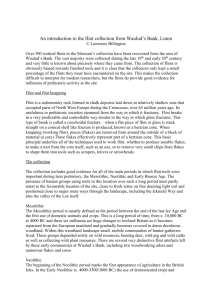Access Cambridge Archaeology
advertisement
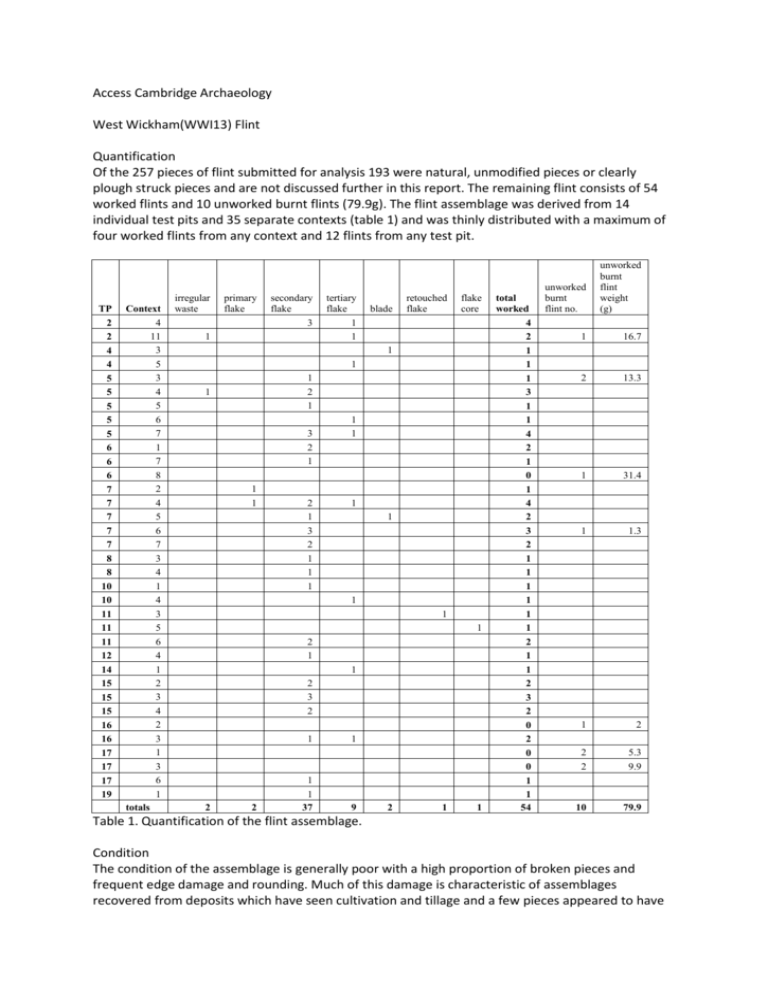
Access Cambridge Archaeology West Wickham(WWI13) Flint Quantification Of the 257 pieces of flint submitted for analysis 193 were natural, unmodified pieces or clearly plough struck pieces and are not discussed further in this report. The remaining flint consists of 54 worked flints and 10 unworked burnt flints (79.9g). The flint assemblage was derived from 14 individual test pits and 35 separate contexts (table 1) and was thinly distributed with a maximum of four worked flints from any context and 12 flints from any test pit. TP 2 2 4 4 5 5 5 5 5 6 6 6 7 7 7 7 7 8 8 10 10 11 11 11 12 14 15 15 15 16 16 17 17 17 19 Context 4 11 3 5 3 4 5 6 7 1 7 8 2 4 5 6 7 3 4 1 4 3 5 6 4 1 2 3 4 2 3 1 3 6 1 totals irregular waste primary flake secondary flake 3 1 tertiary flake 1 1 blade retouched flake flake core 1 1 1 2 1 1 3 2 1 1 1 2 1 3 2 1 1 1 1 1 1 1 1 1 1 2 1 1 2 3 2 1 2 2 1 1 37 1 9 2 1 1 total worked 4 2 1 1 1 3 1 1 4 2 1 0 1 4 2 3 2 1 1 1 1 1 1 2 1 1 2 3 2 0 2 0 0 1 1 54 unworked burnt flint no. unworked burnt flint weight (g) 1 16.7 2 13.3 1 31.4 1 1.3 1 2 2 2 5.3 9.9 10 79.9 Table 1. Quantification of the flint assemblage. Condition The condition of the assemblage is generally poor with a high proportion of broken pieces and frequent edge damage and rounding. Much of this damage is characteristic of assemblages recovered from deposits which have seen cultivation and tillage and a few pieces appeared to have classic ‘plough notch’ damage (Brown 1996). Cortication (patination) is present on a minority of pieces and does not appear to be a strong chronological indicator, occurring on pieces with varied technological traits. Raw Materials The assemblage is made up exclusively of flint, varied in terms of colour and texture but dominated by dark grey and fine grained flint. Surviving cortical surfaces are generally abraded and thin or made up of anciently recorticated thermal surfaces. There is no evidence for flint from a primary chalk deposit and the characteristics of most of the flint suggest a source in the glacial till (the chalky boulder clay) in the immediate environs of the village (BGS 2002). Composition and dating The worked flint assemblage is made up almost exclusively of unretouched flakes. A single very small flake core was recovered and only a single piece with definite secondary working was identified. The varied technological traits and condition of the worked flint assemblage clearly indicate the assemblage is multi period. Blade based material of Mesolithic or earlier Neolithic date is rare, comprising to bladelet fragments from Test Pit 4 and Test Pit 7. There is a larger proportion of relatively systematically worked flake based material likely to be of later Neolithic or Early Bronze Age date. These include two refitting flakes from context 7 in Test Pit 5, both are secondary removals struck from a cortical platform. It is unusual to find refitting material in such a small, multi period assemblage and its presence suggests that the deposit encountered in Test Pit 5 may represent a undisturbed prehistoric context, either a buried soil/old land surface or feature fill. The remainder, and majority, of the assemblage is made up of expediently produced flake based material. This material is characterised by an unsystematic approach to core reduction evinced by frequent knapping errors and irregular morphologies. Some of these pieces, particularly a number of small primary and near primary flakes may be accidentally (plough) struck. The only retouched piece in the assemblage, a thick flake with irregularly steep lateral retouch is similarly the product of an expedient and unsystematic technology. This flintwork is likely to relate to later prehistoric (post Early Bronze Age) flint working. Flintwork of later prehistoric date is characterised by a marked decline in the skill and care used to work flint as well a dearth of formal tool types and the use of inferior, locally derived raw materials (see Ford et al 1984, McLaren ). Summary The size and character of the flint assemblage from West Wickham precludes any detailed assessment of the exact dating and nature of the activity represented by the worked flint. There is relatively little evidence for early, Mesolithic and earlier Neolithic activity and the majority of the assemblage is likely to relate to post Early Bronze Age activity. The most significant aspect of the assemblage was the recovery of refitting flakes from a single context in test pit 7, which might indicate the presence of in situ prehistoric deposits. References BGS. 2002. Saffron Walden. Solid and Drift Edition: 1:50,000 Geological Map., Sheet 205.British Geological Society Brown, A. 1996. Use and non-use: aspects of the prehistoric exploitation of the fen-edge at Isleham. In, D. Hall The Fenland Project, No. 10: Cambridgeshire Survey, Isle of Ely and Wisbech East Anglian Archaeology 79, 202-12 Ford, S., R. Bradley, J. Hawkes and P. Fisher, 1984. Flint-working in the metal age. Oxford Journal of Archaeology 3, 158-73 McLaren, A.P., 2010. Household Production in the Middle Bronze Age of Southern and Eastern England: The Mid Term Car Park (MTCP) assemblage, Stansted Airport, Essex, England. Lithics 31, 130-51.
